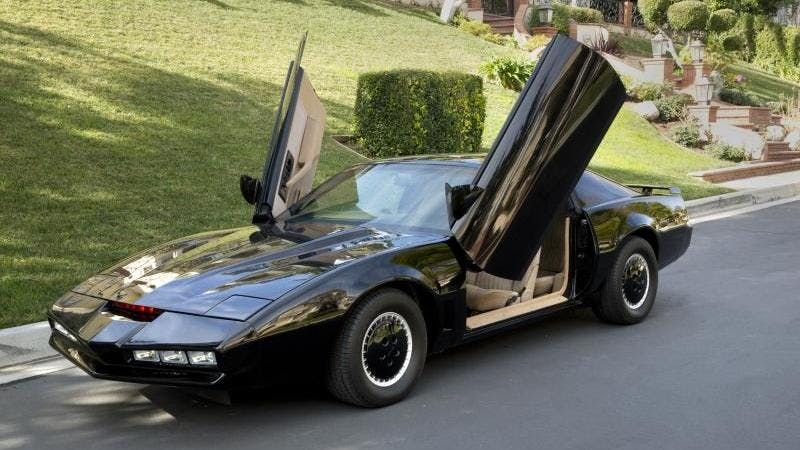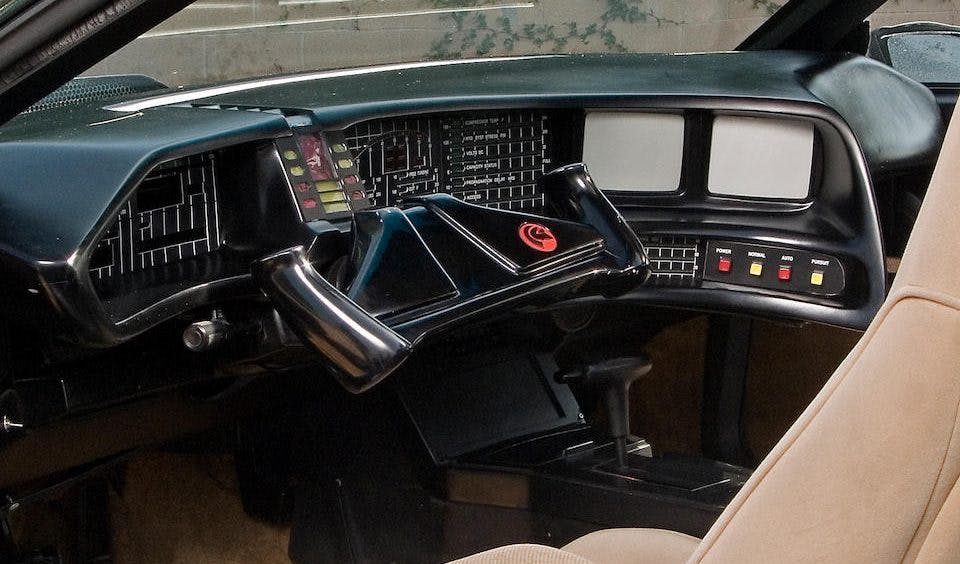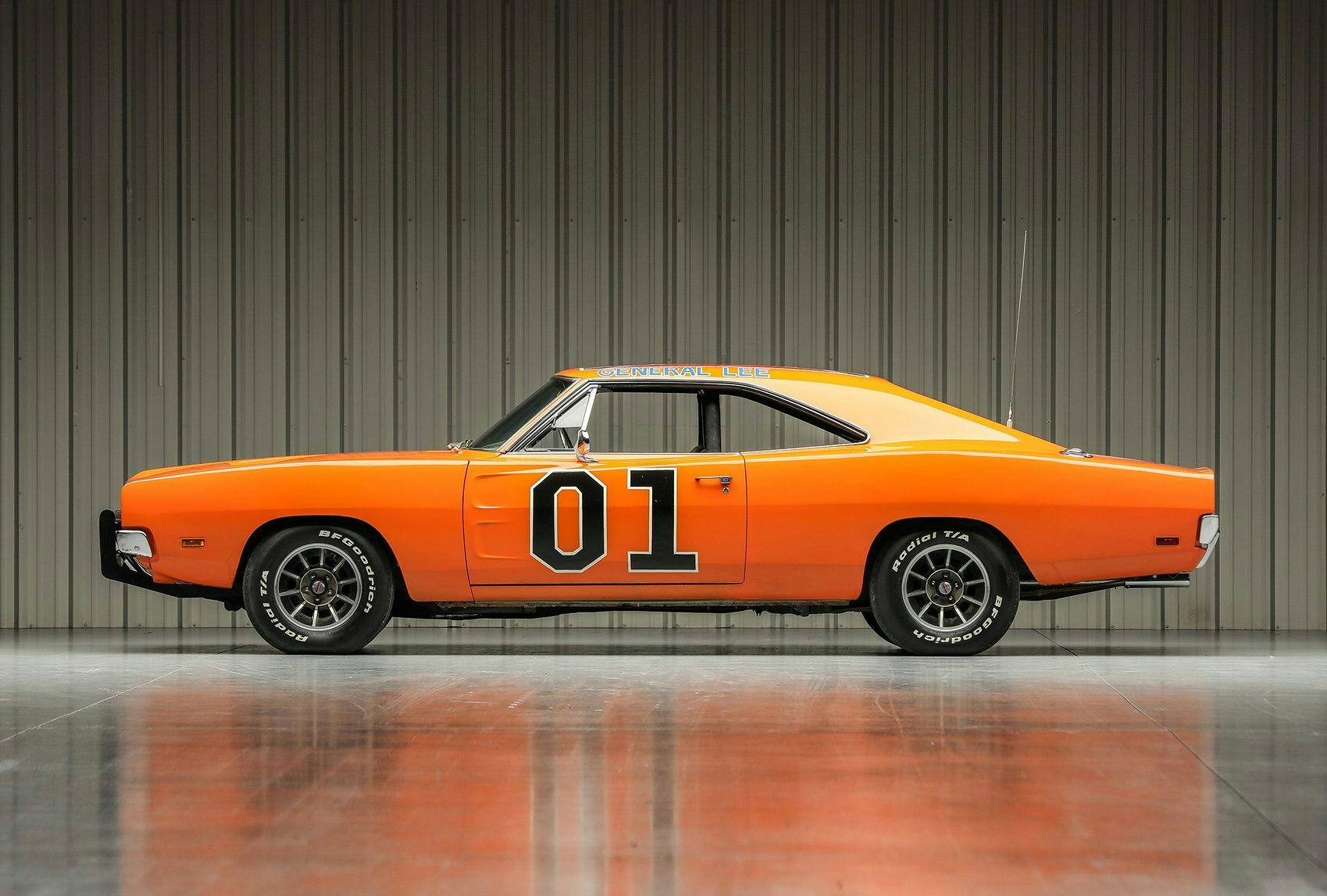Media | Articles
Lights, camera, action: 15 of TV’s most famous vehicles
Lights, camera, action! The small screen has delivered some big hits over the decades—and more often than not the car has been the star. Here are 15 of our favorites, revisited whilst wearing a pair of rose-tinted glasses. See how many you remember.
The A-Team, 1983

Only reachable through their bizarre aliases, the ex-Vietnam vets led by Colonel John “Hannibal” Smith in the A-Team travelled everywhere in a customized GMC G15 van. Its distinctive get-up included a roof spoiler, sweeping red side stripes, 15-inch turbine-style wheels, and exterior sun visor, with bucket seats and a large gun locker inside.
These vigilante do-gooders got through six of these vans through the making of 98 episodes; there were plenty of shoot-outs in The A-Team but almost all confrontations left everyone involved unscathed, even the car crashes. Lt Templeton “Face” Peck, the team’s resident fixer, had a separate ride, a Chevrolet Corvette with its own, distinctive red stripe.
Charlie’s Angels, 1976

Charles Townsend, owner of L.A.-based Townsend Investigations detective agency, gives his all-female operatives their instructions through a loudspeaker in his deserted office. Charlie’s Angels came high-kicking on to our TV screens and stayed around for five series until 1981—115 shows in all—complete with lip gloss, big hair, handguns, and some rather lame 1970s Fords. The original lineup starred Jaclyn Smith as Kelly Garrett, Farrah Fawcett-Majors as Jill Munroe, and Kate Jackson as Sabrina Duncan, all supposedly ex-LAPD officers. Sabrina drove a Pinto and Kelly a Mustang II, but it was Jill’s V8 Mustang II Cobra that became synonymous with the show, even after Fawcett-Majors left after the first season and Cheryl Ladd grabbed the Cobra’s keys.
The Dukes of Hazzard, 1979
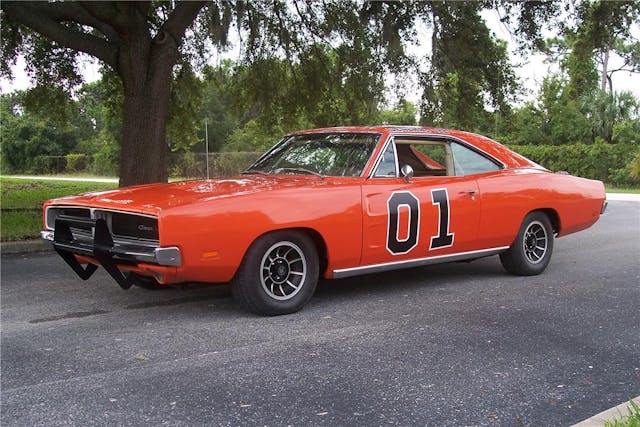
The Dodge Charger achieved domestic acclaim in the late 1960s and early ’70s when it became the car to beat in NASCAR racing. But it was nothing to the international fame bestowed upon it by The Dukes of Hazzard, a TV action-comedy that defined early ’80s Saturday night entertainment. In the spirit of American independence brothers Bo and Luke Duke in the Deep South county of Hazzard are maverick rule-benders who use their Dodge Charger for high-speed escapes and to outwit dodgy lawmen.
Marketplace
Buy and sell classics with confidence
The orange 1969 Dodge Charger was known as “The General Lee” after Robert Edward Lee, a Confederate general in the American Civil War. Every episode involved breathtaking driving staged by expert stuntman Jack Gill, as the Charger, its doors firmly welded shut, hurtling through the air. It’s calculated over 280 cars were destroyed for filming, with about 20 surviving.
The Equalizer, 1985
The vigilante justice-seeker taking center stage in each hour-long episode of The Equalizer was British, played by a scowling Edward Woodward. However, it was through the streets of New York that he prowled in his black, 1984 model Jaguar XJ6 Series III with registration number 5809-AUG (it also appeared prominently in the credits). Robert McCall was his character, a dour former spook with a shadowy espionage agency known only as “The Company.”
McCall set himself up as a private detective determined to give something back for free to deserving “ordinary” people. They contacted him by answering his newspaper small ad, which read: “Got a problem? Odds against you? Call The Equalizer, 212-555-4200.” The Jag was a perfect match for the immaculate McCall image, complete with his black driving gloves, throughout the 88 shows made.
The Fall Guy, 1981

There was so much action-adventure packing U.S. TV screens by the early 1980s it was getting impossible to devise any new scenario mixing crime with squealing tires and hair-raising oversteer. So Glen Larson stripped it all back for The Fall Guy and simply made a stuntman the central character. Lee Majors was Colt Seavers, daredevil to the Hollywood studios, but he still needed an unexpected side, and so was also an illicit bounty hunter. As well as the many cars he pounded to scrap in the name of cinematic gold, his regular wheels were a GMC K-2500 Wideside pick-up, and GM furnished three of these with centrally mounted engines to stop the hefty truck from pitching forward when leaping for the camera.
Hart to Hart, 1979

Robert Wagner, as Jonathan Hart, was the epitome of a self-made American, the millionaire owner of Hart Industries. His wife Jennifer Hart (Stefanie Powers) had that utterly implausible occupation of the idle rich: authoress. They live with cute canine Freeway and wrinkled retainer Max. Having, literally, everything, the Harts turned to amateur detective work to get their kicks out of righting wrongs.
The plebeian products of Detroit were not welcome here in 1980s L.A.: the Harts drove strictly imports. For Jonathan it was the cushioned splendor of a black Rolls-Royce Corniche registered 1 HART, for Jennifer the louche pleasures of a yellow Mercedes-Benz 450SL registered (cringe) 2 HARTS, and upgraded to a 380SL in 1981. This show was extraordinarily popular, syndicated in 60 countries and with 110 installments shot in five series until 1984.
Knight Rider, 1982
Few action dramas have been as much of a “car” show as Knight Rider. After all, one of the main characters was a car. Its creator Glen Larson has said: “I wanted to do The Lone Ranger with a car … a kind of sci-fi thing with the soul of a Western.” The main protagonist here was Michael Knight (David Hasselhoff). He was a former undercover cop turned justice-seeker, assisted not by a trusty stallion but with the autonomous, 200-mph KITT, standing for Knight Industries Two Thousand—the ultimate in high-tech cars. This was essentially a fantasy version of the third-generation Pontiac Firebird Trans-Am. Some people genuinely believed KITT’s gadgetry came as standard, plaguing Pontiac dealers to such an extent that Larson was commanded by General Motors never again to credit the car as a Pontiac or a Trans-Am.
Kojak, 1973

In outline Kojak was pretty much a routine cop show, but for the fiesty performance of Greek-American actor Telly Savalas in the title role. Theo Kojak, while cussed, was immune to corruption in the New York City Police Department where he served, and conducted himself with a swagger commensurate with his stocky, dapper appearance. The show made a TV star of an otherwise humdrum automobile, as Theo used successive brown Buick Century sedans to screech around town. (You’d never have seen one in the U.K., even though you might have owned the 1:36 scale Corgi version. Cigarette smoking was an increasing no-no in the mid-1970s, so Kojak instead sucked continually on lollipops.)
Magnum, P.I., 1980

Tom Selleck was Thomas Sullivan Magnum III, Private Investigator, a man adjusted reasonably happily to life after serving with the U.S. Navy in Vietnam. He was resident security man at a private beach house where he was employed by sniffy Englishman Jonathan Quayle Higgins, called “Higgy Baby” by Magnum. He was, though, even more memorable as TV’s most famous Ferrari driver.
Throughout the entire run of Magnum PI, Magnum gets to drive a Ferrari 308 GTS. In fact, this could be one of three cars because filming began with a 1979 308 GTS, shifting to a 1981 308 GTSi, and then a 1984 308 GTS QV. As they all looked near-identical, any of these Dinos quickly became known as “the Magnum PI car,” yet Selleck was so tall—and the Ferraris so small—the padding had to be removed from the each driver’s seat cushion so his head wouldn’t protrude from the targa top during filming.
Miami Vice, 1984

Detective James Crockett’s appearance, unshaven and with a T-shirt under his pastel-colored, sleeves-rolled-up jacket, was a seminal 1980s style statement. Don Johnson’s Crockett enjoys an apparently high-octane lifestyle thanks to the Miami-Dade County Vice Department. As “Sonny Burnett,” he lives on a yacht and drives a Ferrari. However, all these toys are simply part of his undercover disguise as one of the drug-runners he’s tasked with catching.
His Ferrari is a black 365 GTS/4 Daytona Spider, and it certainly put in some spirited performances chasing villains through the Miami streets. In fact, it was a McBurnie replica, based on a 1980 Chevrolet Corvette. The show’s wild global popularity proved uncomfortable for Ferrari because viewers believed the car was genuine. So they offered the producers a brand-new, 180-mph Ferrari Testarossa in white for the third season in autumn 1986.
The Monkees, 1966
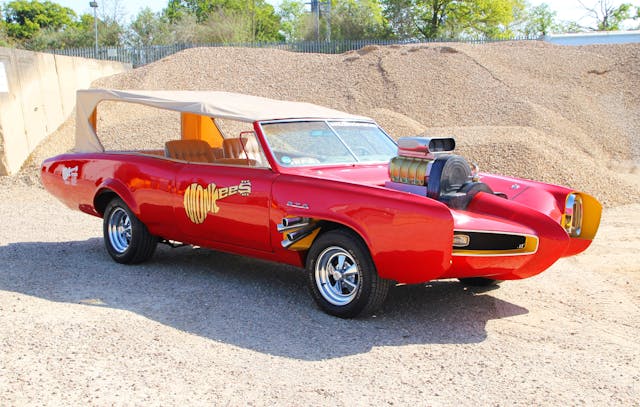
The Monkees were famously dubbed the “Pre-Fab Four” because the band featured in this comedy show were Beatles clones invented by the American TV industry. Micky Dolenz, Mike Nesmith, Peter Tork (all American), and Davy Jones (British) were working musicians when they auditioned for the parts, but their numbers were recorded by session musicians during production; only later did they use the show as a springboard to an actual pop career.
The Monkees’ on-screen car was also craftily fabricated. The Monkeemobile was designed by renowned U.S. customizer Dean Jeffries, his flamboyant rethink of a Pontiac GTO. He made two of them, one for filming and another for promotions, in just one month. The transformation included a convertible top like a Ford Model T “bucket” hot rod’s, a third row of seats in the boot, and radically altered front and rear styling. Pontiac hated the eccentric-looking end result, but it was too bad – the cameras were already rolling.
The Persuaders!, 1971
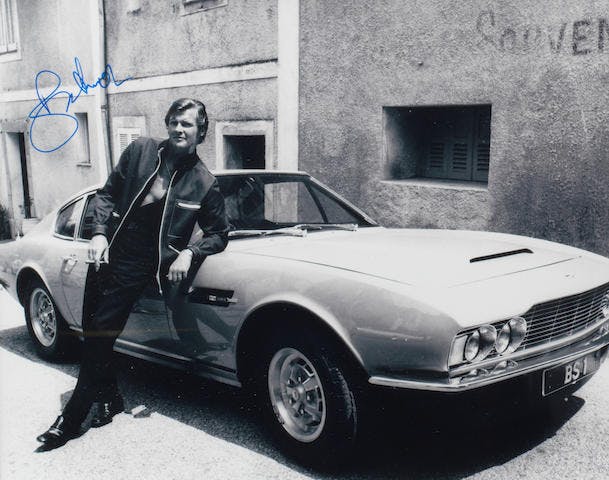
Two wealthy playboys who spent their days lounging around on the French Riviera were roped into justice-seeking by a retired judge, who kept files on villains he’d still dearly like to bring to book. This scenario would have been too contrived had not the casting been perfect. Roger Moore was allocated the part of Lord Brett Sinclair, a racy British aristocrat, and Hollywood A-lister Tony Curtis became Danny Wilde, a New York business tycoon who’d come from nothing in the Bronx.
Theirrapport on-camera and off was immediate, and producer Bob Baker knew he’d have to find the right cars for his characters. Aston Martin provided a six-cylinder DBS in Bahama yellow for Lord Sinclair, and Ferrari supplied a bright red Dino 246GT for Wilde. While a reasonable hit worldwide, it flopped badly in the U.S. where ABC scheduled it opposite CBS’s Mission: Impossible, and just one series was made.
The Rockford Files, 1974

The show did more to stoke the desire for telephone-answering machines than cars. Every episode opened with the main man’s recorded message croaking out of his push-button gadget. “This is Jim Rockford. At the tone, leave your name and number. I’ll get back to you.” Beep. It was usually a client whining about late payment of his “$200 a day, plus expenses” rate. A compelling James Garner inhabited the sardonic, slacker role as freelance private detective.
Rockford lived on an L.A. trailer park but drove the latest Pontiac Firebird. For the celebrated opening season this was a Firebird Esprit, gold with tan interior and a portable printing press in the back to produce fake business cards for various disguises. Each year, as a new series was aired, he’d have the latest model, always gold; but in later series the Formula 400 version dressed, by the studio, to resemble the more modestly priced Esprit, as stuntmen favored the Formula 400’s stiffer suspension, tidier handling, and pokier 400-cubic-inch V-8. Nonetheless, car-mad Garner did most of the on-screen driving himself.
The Saint, 1961, & Return of The Saint, 1978

Roger Moore’s modern-day Robin Hood Simon Templar propelled the Volvo P1800 to instant worldwide recognition in The Saint—although only after Marcos turned down producers. For the TV series based on the best-selling thrillers by Leslie Charteris, he needed an eye-catching and rapid car, but when TV company executives couldn’t secure a Jaguar, they turned to this, the next most desirable car of the day.
ST 1 number plates were always fakes, and used on four successive white P1800 and P1800S cars throughout the 1960s. The show got a reboot in 1978 with Ian Ogilvy replacing Moore as the lead and a Jaguar, a white XJ-S, finally on-screen to whisk him around the European locations, with a rare factory sunroof and manual gearbox …
Starsky & Hutch, 1975
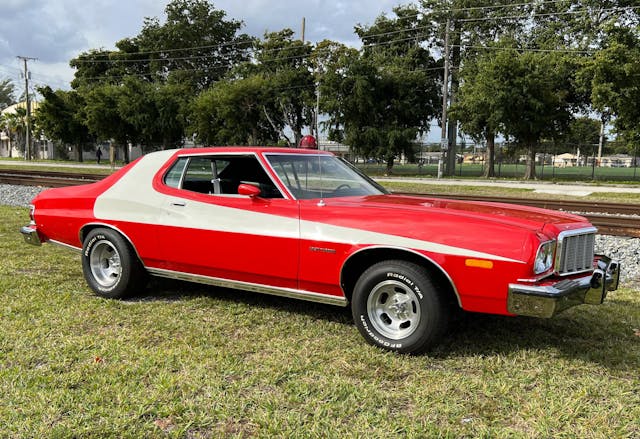
For many, this is the ultimate TV car. When the first series of Starsky & Hutch was broadcast on America’s ABC, the switchboard of Spelling Goldberg Productions in Beverly Hills was jammed with calls from people eager to know what the car was, and where they could get one. The way it had been dressed up for filming was almost as sensational as the pin-ups Dave Starsky (Paul Michael Glaser) and Ken “Hutch” Hutchinson (David Soul)—TV’s first detectives ever to be plastered on girls’ bedroom walls.
Starsky’s ’76 Gran Torino got its distinctive livery of red bodywork with a white stripe along the flanks and over the roof at the suggestion of producer Aaron Spelling. It also gained fat, five-slot kidney-bean mag wheels, and jacked-up suspension. Around a dozen cars were used for all kinds of sequences, including action scenes with an innovative roof-mounted camera. Ford slaked demand by building 1000 limited-edition replicas for public sale, now very valuable.

